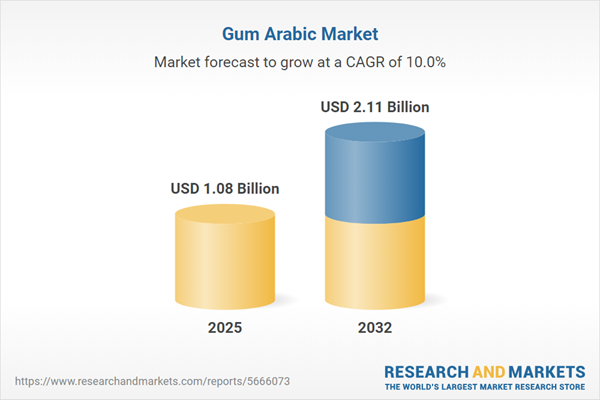Speak directly to the analyst to clarify any post sales queries you may have.
The gum arabic market is experiencing robust growth, driven by its versatility across diverse industries and a rising focus on sustainable and clean-label solutions. As end-user demand evolves and technology advances, senior decision-makers are prioritizing strategies that reinforce supply chain resilience and product innovation.
Market Snapshot: Gum Arabic Market Size and Growth Trend
The gum arabic market grew from USD 987.55 million in 2024 to USD 1.08 billion in 2025. It is expected to maintain a compound annual growth rate (CAGR) of 9.98%, reaching USD 2.11 billion by 2032. Strong expansion is attributed to the ingredient’s adoption in food, beverage, pharmaceutical, cosmetic, and industrial applications. Clean-label movement, sustainability commitments, and new extraction technologies are key contributors to this upward trajectory.
Scope & Segmentation
This report provides an in-depth analysis of the gum arabic market, spanning application, grade, end user, type, sales channel, form, function, and region:
- Application Areas: Cosmetics, food and beverages, pharmaceuticals, printing, and packaging. Within these, hair care, make up, skin care, bakery, confectionery, beverages (alcoholic drinks, juices, soft drinks), dairy products, savory snacks, capsules, syrups, tablets, and topical products are detailed.
- Grade Types: Food grade, pharmaceutical grade, technical grade—each determined by specific purity and compliance needs.
- End Users: Large manufacturers and small and medium enterprises, reflecting distinct procurement strategies.
- Types: Acacia Senegal and Acacia Seyal, providing tailored performance characteristics for diverse formulations.
- Sales Channels: Direct sales and distributor networks support accessibility and supply continuity across geographies.
- Forms: Crystals, flakes, liquid, and powder accommodate varying processing requirements and product designs.
- Functions: Adhesive, emulsifier, stabilizer, and thickener roles that underpin usage in multiple sectors.
- Geographical Coverage: Americas (including North America and Latin America), Europe, Middle East & Africa, and Asia-Pacific, incorporating key national markets within each region.
- Companies Covered: Firms such as Cargill, CP Kelco, Alland & Robert, Archer Daniels Midland, Ingredion, Kerry Group, Agrimer, Dadmun Brothers, National Gum Arabic Company, and Sudanese Gum Arabic Company are analyzed for competitive dynamics and strategic initiatives.
Key Takeaways for Senior Decision-Makers
- Innovation in extraction and processing is delivering higher-purity gum arabic grades, enabling alignment with pharmaceutical, nutraceutical, and advanced food applications.
- Sustainability is a central focus, with companies engaging in ethical sourcing through partnerships with African cooperatives and leveraging technologies for supply transparency.
- Functional versatility positions gum arabic as an essential ingredient in modernization efforts within food, beverage, and cosmetics, supporting demand for natural additives and enhanced product stability.
- Digitalization is transforming quality control and traceability, allowing real-time monitoring and data-driven supply chain management across global markets.
- Regional expansion in Asia-Pacific and the Middle East reflects the push for supply diversification, local processing, and adaptation to dynamic regulatory environments.
Tariff Impact: Evolving Global Trade Dynamics
Recent US tariff adjustments have reshaped procurement and competitiveness within gum arabic supply chains. Importers are reassessing contracts and sourcing, prompting shifts toward alternative regions to offset cost pressures. Vertical integration strategies and flexible logistics, such as bonded inventory, help larger firms buffer the impact, while smaller entities consolidate purchases to remain competitive.
Methodology & Data Sources
This research applies a comprehensive approach, integrating primary interviews with executives, procurement professionals, and technical experts across the value chain. It is supported by surveys with formulators and validated against reputable trade journals and regulatory filings. Advanced analytical frameworks and triangulated demand statistics ensure accurate, actionable insights.
Why This Report Matters: Strategic Value for Stakeholders
- Enables executives to identify growth opportunities and respond proactively to supply chain or regulatory disruptions.
- Supports sustainable procurement decisions by shedding light on ethical sourcing and traceability initiatives.
- Delivers benchmarking for innovation investments, highlighting where technology and sustainability intersect to unlock market advantages.
Conclusion
Gum arabic’s market outlook is shaped by its functional value, sustainability imperatives, and regional diversification. Stakeholders who integrate innovative technologies and responsible sourcing will be poised to capture emerging opportunities and resilient value across evolving global markets.
Additional Product Information:
- Purchase of this report includes 1 year online access with quarterly updates.
- This report can be updated on request. Please contact our Customer Experience team using the Ask a Question widget on our website.
Table of Contents
3. Executive Summary
4. Market Overview
7. Cumulative Impact of Artificial Intelligence 2025
Companies Mentioned
The companies profiled in this Gum Arabic market report include:- Cargill, Incorporated
- CP Kelco US, Inc.
- Alland & Robert SAS
- Archer Daniels Midland Company
- Ingredion Incorporated
- Kerry Group PLC
- Agrimer (UK) Ltd.
- Dadmun Brothers, Inc.
- National Gum Arabic Company Limited
- Sudanese Gum Arabic Company Limited
Table Information
| Report Attribute | Details |
|---|---|
| No. of Pages | 195 |
| Published | November 2025 |
| Forecast Period | 2025 - 2032 |
| Estimated Market Value ( USD | $ 1.08 Billion |
| Forecasted Market Value ( USD | $ 2.11 Billion |
| Compound Annual Growth Rate | 9.9% |
| Regions Covered | Global |
| No. of Companies Mentioned | 11 |









